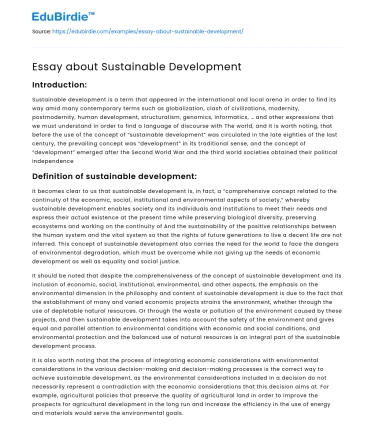Introduction:
Sustainable development is a term that appeared in the international and local arena in order to find its way amid many contemporary terms such as globalization, clash of civilizations, modernity, postmodernity, human development, structuralism, genomics, informatics, … and other expressions that we must understand in order to find a language of discourse with The world, and it is worth noting, that before the use of the concept of “sustainable development” was circulated in the late eighties of the last century, the prevailing concept was “development” in its traditional sense, and the concept of “development” emerged after the Second World War and the third world societies obtained their political independence
Definition of sustainable development:
It becomes clear to us that sustainable development is, in fact, a “comprehensive concept related to the continuity of the economic, social, institutional and environmental aspects of society,” whereby sustainable development enables society and its individuals and institutions to meet their needs and express their actual existence at the present time while preserving biological diversity, preserving ecosystems and working on the continuity of And the sustainability of the positive relationships between the human system and the vital system so that the rights of future generations to live a decent life are not inferred. This concept of sustainable development also carries the need for the world to face the dangers of environmental degradation, which must be overcome while not giving up the needs of economic development as well as equality and social justice.
Save your time!
We can take care of your essay
- Proper editing and formatting
- Free revision, title page, and bibliography
- Flexible prices and money-back guarantee
It should be noted that despite the comprehensiveness of the concept of sustainable development and its inclusion of economic, social, institutional, environmental, and other aspects, the emphasis on the environmental dimension in the philosophy and content of sustainable development is due to the fact that the establishment of many and varied economic projects strains the environment, whether through the use of depletable natural resources. Or through the waste or pollution of the environment caused by these projects, and then sustainable development takes into account the safety of the environment and gives equal and parallel attention to environmental conditions with economic and social conditions, and environmental protection and the balanced use of natural resources is an integral part of the sustainable development process.
It is also worth noting that the process of integrating economic considerations with environmental considerations in the various decision-making and decision-making processes is the correct way to achieve sustainable development, as the environmental considerations included in a decision do not necessarily represent a contradiction with the economic considerations that this decision aims at. For example, agricultural policies that preserve the quality of agricultural land in order to improve the prospects for agricultural development in the long run and increase the efficiency in the use of energy and materials would serve the environmental goals.
What is the 3 transformation to achieve sustainable development?
Environmental dimension:
Sustainable development aims to achieve many environmental goals, as follows:
Rational use of depleted resources, in the sense of preserving natural assets, so that we leave for future generations a similar environment as there are no alternatives to those depleted resources.
Consider the limited capacity of the environment to absorb waste.
The necessity of accurately determining the quantity that should be used from each of the depleted resources, and depends on determining their true economic value, and determining an appropriate price for them based on that value.
The ideal goal of sustainable development is to reconcile economic development with preserving the environment, considering the rights of future generations to natural resources, especially those that deplete them.
Economic dimension:
Sustainable development aims for “sustainable development” for rich countries to achieve continuous reductions in the levels of energy consumption and natural resources, which reach many times in the rich countries compared to the poor countries. For example, energy consumption from oil, gas, and coal in the United States reaches a higher level than 33 times in India.
Social dimension:
The process of sustainable development includes human development aimed at improving the level of health care and education, as well as the element of participation, as the definitions of sustainable development emphasize that development should be participatory so that people participate in making development decisions that affect their lives, Where the human being is at the center of the definitions presented on sustainable development, and the important element that the definitions of sustainable development refer to – also – is the element of justice or equity and equality, and there are two types of equity: fairness for future generations, whose interests must be taken into account according to the definitions of sustainable development, and the second type is Equity for those who live today who do not have equal opportunities with others in obtaining natural resources and social services, and sustainable development aims to eliminate this stark disparity between the North and the South. Sustainable development also aims – in its social dimension – to provide loans to the informal economic sectors and to improve educational opportunities and health care for women.
Conclusion:
The concept of sustainable development has been used a lot at the present time, and the first to officially refer to it in the report “Our Common Future” issued by the World Commission for Development and Environment in 1987, and this committee was formed by a decision of the United Nations General Assembly in December 1983 headed by “ Brundtland “the Prime Minister of Norway and the membership of (22) personalities from the ruling political and economic elites in the world, with the aim of continuing global economic growth without the need for radical changes in the structure of the global economic system.






 Stuck on your essay?
Stuck on your essay?

